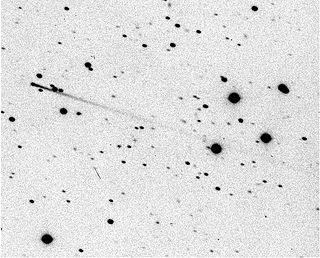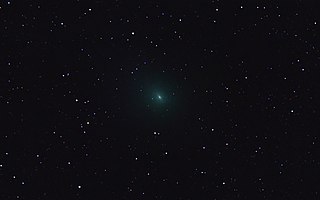Related Research Articles
The Minor Planet Center (MPC) is the official body for observing and reporting on minor planets under the auspices of the International Astronomical Union (IAU). Founded in 1947, it operates at the Smithsonian Astrophysical Observatory.

Comet Elst–Pizarro is a body that displays characteristics of both asteroids and comets, and is the prototype of active asteroids. Its orbit keeps it within the asteroid belt, yet it displayed a dust tail like a comet while near perihelion in 1996, 2001, and 2007.

78P/Gehrels, also known as Gehrels 2, is a Jupiter-family periodic comet in the Solar System with a current orbital period of 7.22 years.

101P/Chernykh is a periodic comet which was first discovered on August 19, 1977, by Nikolaj Stepanovich Chernykh. It will next come to perihelion in 2034.
164P/Christensen is a periodic comet in the Solar System.
170P/Christensen is a periodic comet in the Solar System. It came to perihelion in September 2014 at about apparent magnitude 18.
118401 LINEAR, provisional designation 1999 RE70, is an asteroid and main-belt comet (176P/LINEAR) that was discovered by the Lincoln Near-Earth Asteroid Research (LINEAR) 1-metre telescopes in Socorro, New Mexico on September 7, 1999. (118401) LINEAR was discovered to be cometary on November 26, 2005, by Henry H. Hsieh and David C. Jewitt as part of the Hawaii Trails project using the Gemini North 8-m telescope on Mauna Kea and was confirmed by the University of Hawaii's 2.2-m (88-in) telescope on December 24–27, 2005, and Gemini on December 29, 2005. Observations using the Spitzer Space Telescope have resulted in an estimate of 4.0±0.4 km for the diameter of (118401) LINEAR.

45P/Honda–Mrkos–Pajdušáková is a short-period comet discovered by Minoru Honda December 3, 1948. It is named after Minoru Honda, Antonín Mrkos, and Ľudmila Pajdušáková. The object revolves around the Sun on an elliptical orbit with a period of 5.25 years. The nucleus is 1.3 kilometers in diameter. On August 19 and 20, 2011, it became the fifteenth comet detected by ground radar telescope.
2937 Gibbs, provisional designation 1980 LA, is a stony Phocaea asteroid and Mars-crosser from the inner regions of the asteroid belt, approximately 6 kilometers in diameter. It was discovered on 14 June 1980, by American astronomer Edward Bowell at Lowell's Anderson Mesa Station near Flagstaff, Arizona. The asteroid was named after American scientist Josiah Willard Gibbs.
3040 Kozai, provisional designation 1979 BA, is a stony asteroid and Mars-crosser on a tilted orbit from the innermost regions of the asteroid belt, approximately 4 kilometers in diameters.

238P/Read is a main-belt comet discovered on 24 October 2005 by astronomer Michael T. Read using the Spacewatch 36-inch telescope on Kitt Peak National Observatory. It has an orbit within the asteroid belt and has displayed the coma of a traditional comet. It fits the definition of an Encke-type comet with.

Comet C/2010 X1 (Elenin) is an Oort cloud comet discovered by Russian amateur astronomer Leonid Elenin on December 10, 2010, through remote control of the International Scientific Optical Network's robotic observatory near Mayhill in the U.S. state of New Mexico. The discovery was made using the automated asteroids discovery program CoLiTec. At the time of discovery, the comet had an apparent magnitude of 19.5, which made it about 150,000 times fainter than can be seen with the naked eye. The discoverer, Leonid Elenin, originally estimated that the comet nucleus was 3–4 km in diameter, but more recent estimates place the pre-breakup size of the comet at 2 km. Comet Elenin started disintegrating in August 2011, and as of mid-October 2011 was not visible even using large ground-based telescopes.
255P/Levy, formerly P/2006 T1 and P/2011 Y1, is a periodic comet with an orbital period of 5.25 years. It last came to perihelion on 14 January 2012. During the 2006 passage the comet achieved an apparent magnitude of ~9.5. Levy (PK06T010) was believed to have been recovered on 3 June 2011 at magnitude 19.8, but other observatories were unable to confirm a recovery. It was most likely a false positive because of large residuals. Levy was recovered on 17 December 2011 at magnitude 19.8, and given the second designation 2011 Y1. It was then numbered.
163P/NEAT is a periodic comet discovered on November 5, 2004 by Near-Earth Asteroid Tracking (NEAT) using the 1.2 meter Samuel Oschin telescope at Palomar Observatory.

62P/Tsuchinshan, also known as Tsuchinshan 1, is a periodic comet discovered on 1965 January 1 at Purple Mountain Observatory, Nanking. It will next come to perihelion on 25 December 2023 at around apparent magnitude 8, and will be 0.53 AU (79 million km) from Earth and 110 degrees from the Sun.

246P/NEAT is a periodic comet discovered on 2004 March 28 by Near-Earth Asteroid Tracking (NEAT) using the 1.2-metre (47 in) reflector at Haleakala. It was given the permanent number 246P on 2011 January 14.

209P/LINEAR is a periodic comet with an orbital period of 5.1 years. The comet has extremely low activity for its size and is probably in the process of evolving into an extinct comet.

276P/Vorobjov is a Jupiter-family comet discovered on 15 October 2012 by Tomáš Vorobjov on three 120-s images taken remotely using the 0.81-m f/7 Ritchey-Chretien Schulman Telescope located at the Mt. Lemmon SkyCenter via the Sierra Stars Observatory Network in the course of a minor-planet search survey undertaken as part of the International Astronomical Search Collaboration (IASC) school campaigns. After posting on the Minor Planet Center's NEOCP webpage, other observers have commented on the object's cometary appearance. The discovery was announced by the Minor Planet Center on 18 October, three days after the discovery.
75D/Kohoutek is a short-period comet discovered in February 1975, by Luboš Kohoutek. Even on the discovery plate the comet was only apparent magnitude 14. Assuming the comet has not disintegrated the 2020-2021 perihelion passage is only expected to peak around apparent magnitude 20.
266P/Christensen is a periodic comet in the Solar System. It will next come to perihelion in December 2026. It has been suggested as the source of the 1977 "Wow! Signal".
References
- ↑ "335P/Gibbs Orbit". Minor Planet Center . Retrieved 2017-06-08.
- ↑ Syuichi Nakano (2016-02-09). "335P/Gibbs (NK 3062)". OAA Computing and Minor Planet Sections. Retrieved 2017-06-08.
- ↑ Paris, Antonio (Winter 2015). "Hydrogen Clouds from Comets 266/P Christensen and P/2008 Y2 (Gibbs) are Candidates for the Source of the 1977 "WOW" Signal" (PDF). Washington Academy of Sciences. Retrieved 7 June 2017.

